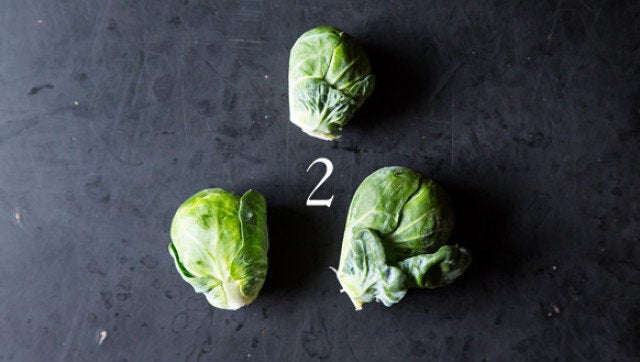
Every week we get Down & Dirty, in which we break down our favorite seasonal fruits, vegetables, and more by the numbers.
There's a lingering stereotype about brussels sprouts that says they're mushy, funky, and to be avoided. Not so! Brussels sprouts, which originated in Northern Europe in the 13th century or so, are actually the greatest of all brassicas: they have cabbage's vegetal sweetness, kale's versatility, cauliflower's nuttiness, and more surface area (which equals more potential crispiness) than just about any other vegetable.
1. Baseball Bat: Yes, this is what a stalk of brussels sprouts looks like! (If you've ever seen a kale plant, which has leaves coming off a thick central stem, this will be familiar.) The sprouts reach maturity from the bottom up -- in fact, you can harvest sprouts from the bottom and the stalk will keep growing on top, which means you'll have brussels sprouts all season long. When the stalk reaches 2 feet or so in length, it's customary to "top" them by pinching off the top-most sprouts. This forces the stalk to put its energy into developing its existing sprouts instead of growing new ones it may not be able to support before the frost.
2. Baby Cabbages: Off the stalk, this is what you get: 1-2" orbs that look like tiny baby cabbages. It's customary to trim away any yellowed or oversized leaves before cooking, but otherwise these are ready to eat. Like many other vegetables, they start to lose their sweetness after picking. Keeping them on the stalk delays this process a bit, but eat your sprouts quickly! And keep an eye out for the heirloom Rubine variety of brussels sprouts, which are a gorgeous shade of bright purple due to the anthocyanin flavonoids in the plant. (See also: cabbages, grapes, and kohlrabi.)
3. Core of the Matter: To increase surface area and allow for more even cooking, it's best to halve sprouts; whole ones can get mushy in the middle despite their crisp exteriors. No need to cut out that core as you would for a cabbage -- it's tender and quick to cook.
4. In the Raw: Of course, you don't have to cook your sprouts at all! The loosened leaves make for a great slaw. Keep in mind though, that the delicate leaves wilt quickly under acidic dressings -- dress raw brussels sprouts salads just before serving.
Versatile and delicious, there are dozens of Food52 recipes for brussels sprouts -- so many that you could try a new preparation every meal for days: deep-fried, glazed, shredded, and even grilled. What's your favorite way to cook brussels sprouts?
Photos by James Ransom